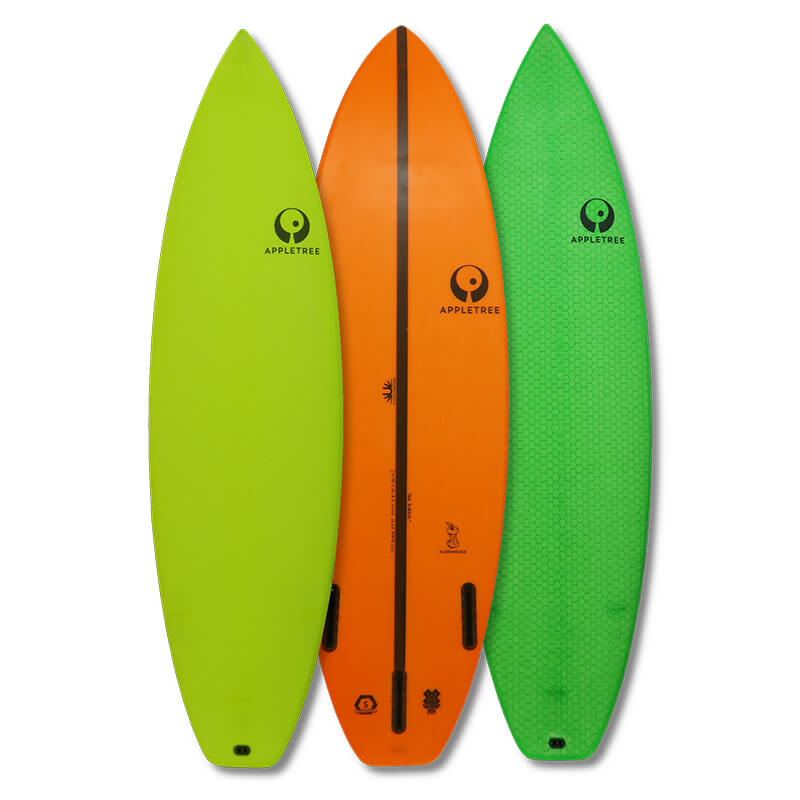When you purchase gear through links on our site, we may earn a small commission. Here’s why you can trust our tests and our affiliate partner.

Appletree was founded by two brothers, who initially manufactured in a shed on a Dutch apple farm owned by their parents. From these small seeds, a mighty orchard has grown, into the shape of their own bespoke board production facility in Portugal with their own in-house designed CNC machines for milling a specific type of 50kg/m waterproof closed cell foam that they use across their board range, which spans directional kiteboards, wing, foil as well as traditional surfboards.
Appletree offer a full customization service for each board model; this starts with dimensions, several different laminate choices, a choice of Futures or FCS2 fin boxes, inserts, tail dips, all the way down to a custom message to the lucky recipient on the stringer.
First off we’d like to congratulate Appletree on some genius packaging. They’ve reused the aforementioned foam block that they cut your board from to provide some perfectly tailored lightweight bump protection for your board in transit, turning waste into something very useful. It’s also worth noting they are approved by Sustainable Surf.
We were presented with the Klokhouse to test, probably one of the most classic surfboard shapes in their extensive range with a squash tail and gently rounded outline. We tested the tougher S-glass construction, and fitted some medium size Futures fins. The EVA pad is perfectly designed to match the board, so it fits perfectly into the tail, and the kick sits exactly where it should over the fins. It’s relatively thin to give you a good connection to the board. The ribs run parallel to the rail, meaning it’s easy to slide your feet for foot transitions and weight shifts for balancing the board upwind, but means you have better grip rail-to-rail for pushing hard into a top turn. There’s also a raised section in the center of the kickpad that sits under the arch of your foot to help you centrally locate your rear foot without having to look down. This is particularly useful when riding further up the board to pinch upwind, and then wanting to get your rear foot back over the fins to throw some spray. You don’t have to look down, which when the conditions are more consequential, makes a big difference.
You’ll notice a hexagonal pattern on the deck – this isn’t there for decoration. The S-glass board we rode has a sandwich construction over the majority of the deck to reinforce it, avoiding heel dents. It feels tough enough underfoot to do strapless airs on without any worries.
In the water the squash tail combined with the rounded outline feels lively and agile, and probably suits waist-high surf plus up. The rocker is intelligently placed and well balanced enough to clear some steep drops and big lumps of whitewater, without a huge sacrifice on upwind performance. The flex level in the board provides a decent level of response and enough shock absorption to ride comfortably through chop without feeling spongy; the gentle single concave also feeds into this smooth and controlled nature. The Klokhouse likes to maintain speed and doesn’t suffer from any nose flap, it seems to skim through a choppy sea state with level of composure.
The low volume in the tail gives you the option to add rear foot pressure and slow yourself down on the wave allowing you to get a better position on the face. Its nimble nature lends itself to a very vertical top turn with plenty of grip at the critical moment, and reliable re-entry into a steep face.
It’s great to see a young company produce such a high quality product, both in terms of performance and manufacturing, and to high environmental standards. The Klokhouse is going to suit riders coming from more of a dedicated surf perspective, who want to focus on drawing satisfying lines on waves precisely where they want them.
